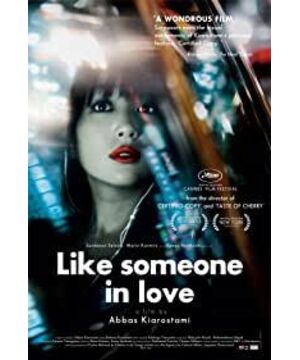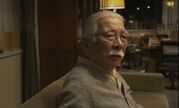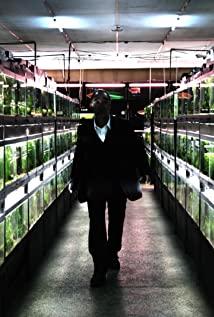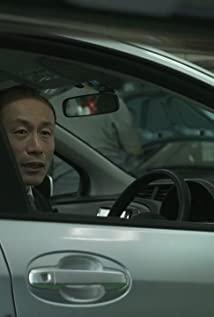My movie has no beginning and no ending. ——Abbas Kiarostami As the last film that Kiarustami completed during his lifetime, "Like a River in Love" did not receive the attention it deserved. The incomplete narrative method adopted by the director adds obstacles to the understanding of the film, but what ultimately conveys is a typical "Abbasian" reflection on the image. Pulling aside the shell of the plot, this film can be seen as an extension of the previous work "Reproduction as it is". As far as the narrative and image significance of the film is concerned, "Ru" goes further on the basis of "Original". Similar to "Yuan", both films involve the issue of authenticity of "identity".In "Original", the hero and heroine "played" the role of husband and wife due to a misidentification, and the fictional husband and wife identity replaced the previous character setting. The contradiction in "Original" stems from the fact that the role is fake, and the true self in the character's heart is achieved by giving up the original identity, which makes it difficult for the audience to distinguish the authenticity from the fake. By deconstructing the "authenticity" of identity, the film-like plot setting of the thesis makes the audience rethink the proposition: the value of an artwork depends on the way of viewing rather than the concept of authenticity. Furthermore, the meaning of identity deconstruction and reconstruction does not stop at identity itself. The replication of an identity is endowed with its identity because of its function. Replication is a functional replication, and its meaning is only in the relationship that interconnects the functions to play their role; relatively speaking, the emotion that extends from the identity is the closure. of. Emotion is rooted in the existence of the individual rather than its functionality, and the real experience of emotion cannot be replicated (the double reproduction of reality and itself by film does not indicate what the film means to the viewer). "Like all stories, this one is repetitive, but everyone is original." (Abbasid) The exploration of identity makes the film a direct reference to the emotional value of human beings. In "Ru", the situation is much more complicated, and the core of the film cannot be touched only from the perspective of "deconstruction" of identity: the heroine Akiko hides her identity from her boyfriend and her family because of her engagement in aid communication, and makes a living Relationships with intimacy, family, and studies reflect the multiple contradictions of identity. Not only that, the originally unfamiliar girl was given a status similar to "family" through the way the old man "watched" her. This identity was further affirmed through the conversation between the old man and his boyfriend. Like "Original", the external causes of the "false" identity are all misunderstood by others. The difference is that the dilemma in "Ru" stems from the revealing of the characters' real identities in the film rather than the fictional play of identities. In this process, the characters are sober and their identities are determined. There is no illusion that confuses reality, but only a concealment of reality. The thesis-style proposition of Yuan has become the self-evident premise of the film. If "Yuan" reveals truth through fiction, "Ru" reveals lies through truth.In the film, the grandmother and her boyfriend chose not to believe it after seeing Akiko's photo in the advertisement, and emotion became an accomplice to hide their identity. Kiarustami once said that he prefers lies to the truth, because the lie reflects the inner truth of the character more than the superficial truth. The girl's repression of her inner emotions broke out shortly after the beginning of the film, and after the lie was exposed, the angry outburst of her boyfriend pushed the film to a climax. Here, glass is used a lot as a medium of some kind of symbol. Shortly at the beginning of the film, Mr. Koji’s image of the interior space of the bar and the outside are overlapped by the glass wall, thus completing the “polyphonic” vertical spatial composition on the same plane. The echo here with the first shot hints at Akiko's situation: the use of the first subjective long shot forms the character's subjective perspective while dragging us immediately into the reality of everyday life in the film, while the glass wall will be filled with The space with a sense of occlusion is further exposed, and the girl has changed from a viewing subject that was not previously displayed on the screen to an object to be viewed below the screen. Glass becomes a paradox: it isolates the space while exposing it. When the girl looks at her grandmother through the rolling window in the taxi, the peeping grandmother is unaware of her situation, she cannot see Akiko, just as her identity is her unwillingness to believe the truth presented in the photo ( Ironically, Akiko also didn't expect her photo to be seen by her grandmother, who, while she tried her best to hide herself, was exposed in another way). In the car, although the mirror does not appear in the picture, we can confirm from the movement of the driver's eyes that he is peeping at the girl. Later in the apartment, the girl walked into the bedroom, and the mirror on the left wall of the screen formed a double image of the object. In the bedroom, the TV screen beside the old man reflected the girl's figure (in "Original", a similar composition is of a woman. The image of the protagonist projected on the screen through a mirror). In addition, the neighbor's peeping behavior of the street through the window further highlights the significance of glass as a medium of perspective. The dual meanings of exposure and concealment are combined into one, and the result of the same behavior of the old man at the end of the film is given to It has a deeper meaning - the fragility of peeping perspectives and means of isolation. In this sense, the glass happens to constitute the opposite of the mirror image, through which we hope to be a peeping person while hiding ourselves, which is ultimately futile. The use of sound in the film also implies this "polyphonic" relationship. Compared with the camera lens, Chiarustami's two-track sound effects produced by borrowing indoor and outdoor simultaneous recordings more clearly emphasize the relationship between the inner and outer spaces and the characters. In the bridge filmed in the apartment for the elderly, the outdoor noise is very clear: during the conversation between the two, the noise of a car passing by completely overwhelmed the jazz playing indoors, as if suggesting the real environment of the indoor space— — A crisis that is always disturbed by forces originating from outer space . Interestingly, corresponding to the car noise here, the final disruption of the space balance was caused by a boyfriend who is an auto mechanic. Here, corresponding to the "overlapping image" of the camera lens, the overlapping sound effects separate the sound from the picture and imply another level of parallel narrative (in the film "Princess Xilin", the director fully expressed the almost experimental approach. this topic). If the subversion of the narrative in "Original" comes from the transformation of the viewer's view itself caused by the textual setting of identity, the transformation in "Ru" stems from the limitation we are limited by our perspective. From the first shot, the director condenses the audience's perspective on the peeping of the girl. With the development of the plot, the center of our peep gradually shifts from the girl to the old man, and the fluctuating emotions of the boyfriend lay the groundwork for the final perspective of the film. With speculation about the old man's motives, there is another perspective flip near the end of the film: the peeping of the neighbor next door makes us realize the exposure of the environment in which the two behave. The subjective long shot used here echoes the first shot of the film, and Chiarustami uses only two subjective shots to successfully make us switch from the perspective of the characters in the film to the voyeuristic nature of the image.Different from the playful reversal of the audience's "God's perspective" in "Original", this film deprives the audience of God's perspective and confines it to the screen from the beginning, and the audience's understanding is parallel to the film's narrative. At this level, different perspectives form a linear narrative of the same event, and the incomplete narrative adds a strong hint of meaning to the film. As mentioned before, peeping embodies the concealment of oneself in the process of viewing so as not to be noticed by others. And this hidden consciousness is the same as the girl and the old man's concealment of their own identity in the film. At the end of the film, the angry throw of the boyfriend broke the window and vented his anger after the lie. The old man who had peeped out the window fell down, leaving us with an empty scene covered by a curtain, as if to imply our situation as voyeurs. So, with a loud bang, the barrier is broken, the lie is broken, the hiding place of the voyeur is broken, and further, the peeping itself is broken, and the film comes to an abrupt end. The shattering of the window not only implies the shattering of the fictional nature of the image, but further, it also hits us, making us feel uneasy about the environment we are in, like the characters in the movie, and then we are thrown out. The identity of the spectator becomes the spectator from the director's perspective. From this point of view, "Ru" breaks through "Original". In "Original", after the conflict, the two people come to the hotel of 'once', the woman is still immersed in the 'memories' of the past, and the man's sentence: 'I have to catch the train at nine o'clock' will force the viewer to Pulling back the reality in the film makes the viewer have to face the original truth. To this extent, the director reveals to us the essence of the fiction of the image. And the final blow in "Ru" plays a similar function to the line in "Yuan" to some extent, but this time, what is implied is the fictional nature of life - life is defined by different perspectives. narrative, and any narrative implies an element of fiction. The cinema seems to place people in a camera obscura. Here, the audience is isolated from the world. The mirroring function of the screen not only reflects the audience’s self, but also satisfies people’s collective desire for voyeurism. We are safe.The last blow in "As" seems to be a prank-like fright that the director deliberately aimed at the audience. The meaning of the image extends from the screen to the entire viewing space, and then creates a "reflection" style through the fiction of the image and the reality of life. inversion and superposition. In this process, the deconstruction of the real space finally provides the power beyond the text and the image through the characteristics of "anti" image, and this power is real. And after that? The end of the film is like a question. We don't know the fate of the old man and the young girl, just as we have no way of knowing the motives of the old man and the cause of the young girl. The film seems to have been directly intercepted for a main part, leaving the audience blank and thinking more than the bearing of the plot itself. It is true that the interruption of the narrative creates an obstacle to the understanding of the film, and the obstacle itself becomes a symbol that presupposes the necessary contradiction. The interruption is accidental, it does not determine the turn of events, and the unfinished narrative is the result of a violent interruption. In "Original", the conversation between the two was interrupted by the ringing of the man's mobile phone, followed by the misunderstood conversation between the woman and the proprietress, which gradually led the film to another path. Here, the occasional interruption provides an opportunity for a plot twist. In "Ru", the several bells in the old man's room, under the director's interesting arrangement, only indicated the connection between the character and the outside world. The "interruption" did not really play a role in the direction of the plot. There is some kind of "sustain" effect. If "Yuan" is a novel full of stories, then "Ru" is more like a musical work. Not only telephones, voicemails, cars, glass, mirrors, curtains and other elements in the film are used repeatedly, but many scenes also appear in the form of repetition or variation: the role settings of grandma and "grandfather", the girl and the person in the painting similarities, photos seen by both grandmother and boyfriend (does it imply that the old man also knew Akiko in this way), the identity of the sociology professor and student of the old man and the young girl, and the old man's former students, the same "grandfather", twice Misidentifications, interrupted jokes, phone interruptions and voicemails, incoming sleepiness, and more. Through the embedded method of elements in the bridge segment, the interaction between symbols makes the limited material reproduced and deformed to play different meanings in different contexts, resulting in the final "interpretation" of details is plural. . In this sense, similar to music, the content of the form relies on the form itself to function, based on mutual metaphors, rather than limited to literary descriptions and symbols. "Like Someone in Love", in the title, the word like can also be interpreted as a pun. It can be used as a "copy" of the "as-is" to emphasize the repetition and originality of the story itself, or it can be used as a "proposition" to examine the different expressions of the characters' love in the film, and it can be used as a song full of emotion. The jazz songs make people imagine. The whole film is the same as "Original". Strangers meet and meet because of a short encounter, as if it is a love letter from Chiarustami from a different place to Tokyo. In the film, the long shot with a gentle displacement in the interior engraves the sense of space in the shot into the endless flow of time with a comfortable rhythm; the camera's close-up of the characters' expressions and the director's attention to detail arrangements and hints reveal a certain oriental style. Delicate and subtle; several long shots with a few fixed positions, front and back shots in the car, clean editing and jumping all reveal a "Japanese" direct and simple; The subtle control of complex plots reflects the director's in-depth observation and reconstruction of daily life. One of the most impressive moments in the film is Akiko in a taxi, looking out the window while listening to a message from his grandmother. The camera is aimed at the inside of the car from outside the car. The windows and rear windows reflect the neon lights on both sides of the street. The colorful images surround the girl in the car. The girl's painful expression faithfully reflects her inner state; and the next shot It is to point the camera at the street outside the car window, where unrelated people walk or stand still on the track of their lives. The switching of several groups of subjective and objective shots in Chiarustami hints the difference between the Tokyo in the eyes of the girl and the Tokyo we feel off the screen - a superficial sense of reality stemming from prosperity and indifference and the girl surrounded by this sense of reality The emptiness and alienation reflected. After that, the appearance of the grandmother formed a huge contrast with the bustling city. The girl looked at her grandmother, and we observed the girl, as if we had entered her inner world—surrounded by emptiness and prosperity, but thus isolated from the familiar shore and unable to reach in depth. Perhaps this is how Chiarustami feels about contemporary Tokyo, a real sense of fiction and deep alienation, an elusive Japanese quality. The directness and simplicity of the plot; and the subtle control of the uncomplicated plot within the short time span of the plot reflects the director's in-depth observation and reconstruction of daily life. One of the most impressive moments in the film is Akiko in a taxi, looking out the window while listening to a message from his grandmother. The camera is aimed at the inside of the car from outside the car. The windows and rear windows reflect the neon lights on both sides of the street. The colorful images surround the girl in the car. The girl's painful expression faithfully reflects her inner state; and the next shot It is to point the camera at the street outside the car window, where unrelated people walk or stand still on the track of their lives. The switching of several groups of subjective and objective shots in Chiarustami hints the difference between the Tokyo in the eyes of the girl and the Tokyo we feel off the screen - a superficial sense of reality stemming from prosperity and indifference and the girl surrounded by this sense of reality The emptiness and alienation reflected. After that, the appearance of the grandmother formed a huge contrast with the bustling city. The girl looked at her grandmother, and we observed the girl, as if we had entered her inner world—surrounded by emptiness and prosperity, but thus isolated from the familiar shore and unable to reach in depth. Perhaps this is how Chiarustami feels about contemporary Tokyo, a real sense of fiction and deep alienation, an elusive Japanese quality. The directness and simplicity of the plot; and the subtle control of the uncomplicated plot within the short time span of the plot reflects the director's in-depth observation and reconstruction of daily life. One of the most impressive moments in the film is Akiko in a taxi, looking out the window while listening to a message from his grandmother. The camera is aimed at the inside of the car from outside the car. The windows and rear windows reflect the neon lights on both sides of the street. The colorful images surround the girl in the car. The girl's painful expression faithfully reflects her inner state; and the next shot It is to point the camera at the street outside the car window, where unrelated people walk or stand still on the track of their lives. The switching of several groups of subjective and objective shots in Chiarustami hints the difference between the Tokyo in the eyes of the girl and the Tokyo we feel off the screen - a superficial sense of reality stemming from prosperity and indifference and the girl surrounded by this sense of reality The emptiness and alienation reflected. After that, the appearance of the grandmother formed a huge contrast with the bustling city. The girl looked at her grandmother, and we observed the girl, as if we had entered her inner world—surrounded by emptiness and prosperity, but thus isolated from the familiar shore and unable to reach in depth. Perhaps this is how Chiarustami feels about contemporary Tokyo, a real sense of fiction and deep alienation, an elusive Japanese quality.
The passage of the country grandmother into the city is very reminiscent of Yasujiro Ozu and the great "Tokyo Story" (Kiarustami made the film "Five" to pay tribute). In a section of the film, the next morning after shooting, the old man was driving a car, and a young girl was sitting beside him. Both of them were silent. It overlapped with the tired face of the person in the car. With the driving of the car, the pattern changes, plain and beautiful. A good director may only tell one story throughout his life. Like life, the beginning of a story contains an end, and the end of a story is the beginning of another story, as in Kiarostami's films, From "Gone With the Wind" to "Like a River of Love", after the film, people will look forward to the next one. This film also has a name called The End (End), just like the last image left on the screen before the end of the film, and often the real beginning and end of life are not known to us. As the last work completed by Abbas Kiarustami in this life, this film must have been unexpected. Berlin, 18 August 2016
View more about Like Someone in Love reviews











